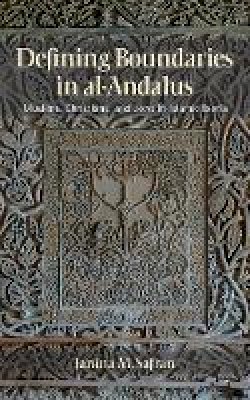10%OFF
Stock image for illustration purposes only - book cover, edition or condition may vary.
Defining Boundaries in al-Andalus: Muslims, Christians, and Jews in Islamic Iberia
Janina M. Safran
FREE Delivery in Ireland
Description for Defining Boundaries in al-Andalus: Muslims, Christians, and Jews in Islamic Iberia
Paperback. Num Pages: 264 pages, black & white illustrations. BIC Classification: 1DSE; HBJD; HBLC; JFSL1. Category: (G) General (US: Trade). Dimension: 235 x 156 x 15. Weight in Grams: 399.
Al-Andalus, the Arabic name for the medieval Islamic state in Iberia, endured for over 750 years following the Arab and Berber conquest of Hispania in 711. While the popular perception of al-Andalus is that of a land of religious tolerance and cultural cooperation, the fact is that we know relatively little about how Muslims governed Christians and Jews in al-Andalus and about social relations among Muslims, Christians, and Jews. In Defining Boundaries in al-Andalus, Janina M. Safran takes a close look at the structure and practice of Muslim political and legal-religious authority and offers a rare look at intercommunal life ... Read morein Iberia during the first three centuries of Islamic rule.Safran makes creative use of a body of evidence that until now has gone largely untapped by historians—the writings and opinions of Andalusi and Maghribi jurists during the Umayyad dynasty. These sources enable her to bring to life a society undergoing dramatic transformation. Obvious differences between conquerors and conquered and Muslims and non-Muslims became blurred over time by transculturation, intermarriage, and conversion. Safran examines ample evidence of intimate contact between individuals of different religious communities and of legal-juridical accommodation to develop an argument about how legal-religious authorities interpreted the social contract between the Muslim regime and the Christian and Jewish populations. Providing a variety of examples of boundary-testing and negotiation and bringing judges, jurists, and their legal opinions and texts into the narrative of Andalusi history, Safran deepens our understanding of the politics of Umayyad rule, makes Islamic law tangibly social, and renders intercommunal relations vividly personal.
Show Less
Product Details
Publisher
Cornell University Press United States
Place of Publication
Ithaca, United States
Shipping Time
Usually ships in 7 to 11 working days
About Janina M. Safran
Janina M. Safran is Associate Professor of History at Pennsylvania State University.
Reviews for Defining Boundaries in al-Andalus: Muslims, Christians, and Jews in Islamic Iberia
[This book's] special genius is its deliberate juxtaposition of the idea of predetermined boundaries between Muslims, Christians, and Jews in al-Andalus with the reality of their perpetual negotation and renegotiation by jurists in light of changes in the historical conext.... For an older generation of Iberianists like me, who originally operated under the assumption that the Arabic sources of early ... Read moremedieval Spain—in marked contrast to the Latin ones—had little to offer on the subject of dhimmis and their relationship to the dominant community, the work of Safran has proved especially eye-opening.
Kenneth Wolf
H-Catholic
[Safran] is able to make such good use of al-Khushani against the background of the whole vast range of the Islamic literature relating to the legal scholarship of Islamic Spain. I must stress the immense amount of coordinated hard work that will have gone into this present study. Perhaps we may hope that Professor Safran will soon in a further volume follow the story through to its sad end in 1492?
L. P. Harvey
Journal of Islamic Studies
Her work is insightful and readable, and it makes a significant contribution to the field of Andalusi and interfaith studies. The use of juridical literature to analyze society is a fast-growing field in Islamic studies, and Janina M. Safran's volume is an important and engaging new contribution.
Amira K. Bennison
The American Historical Review
Janina Safran has written a rich, clearly structured, and readable book. The main contribution of the book is that it consistently details the historical contingencies that formed the legal construction of religious categories and the management of interreligious relation under Umayyad rule. By thoroughly examining legal deliberation, Safran treats Islamic law as a contextual, situated, intrinsically social, and necessarily ambivalent discourse of negotiation, adaptation, and transculturation. In doing so, she spoils the monolithic picture of Islamic law as dogmatic and uniform, just as she disturbs the notion of al-Andalus as a prime example of interreligious tolerance under Muslim rule, offering instead a welcomed and well-researched analysis of the legal management of religious diversity in al-Andalus.
Oskar Verkaaik
Journal of the American Academy of Religion
Safran's analysis is illustrated with many examples and also brings in a wide range of chronicle and other material. The book puts this case law within the reach of any interested reader, in a sophisticated and well-organized discussion.
Ann Christys
Bulletin of Spanish Studies
This important book is a meticulously detailed contribution to the growing body of literature on how Muslims, Christians and Jews lived together in al-Andalus. It stands apart from the line drawn in the 1940s and 1950s by Americo Castro and Claudio Sanchez Albornoz between a happy convivencia on the one hand, and a fractious cohabitation (unavoidable following the Arab-led invasion of a supposedly fully-fledged Christian Spain) on the other.
Stuart Green
British Journal of Middle Eastern Studies
This is a clever and original book, whose importa nce should not be disguised by its compact and economical style. The implications of Safran's arguments have applications far beyond al-Andalus—not only elsewhere in the Islamic world, but also as regards subject Muslim communitie s living under Christian rule.
Brian A. Catlos
Comitatus
We depend on scholars of medieval Islamic law to produce books on the subject as useful and accessible as Janina Safran's Defining Boundaries in al-Andalus... As a scholar of the literary, visual, and material manifestations of Iberian culture, I can think of many ways in which studies such as Safran's might offer us fresh lenses for the examination of these phenomena—far too many to list here.
Cynthia Robinson
Speculum
Show Less


